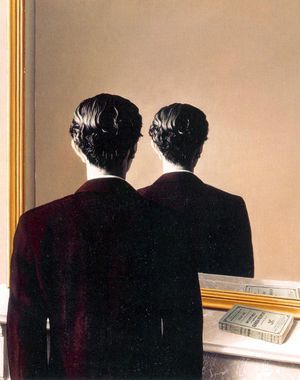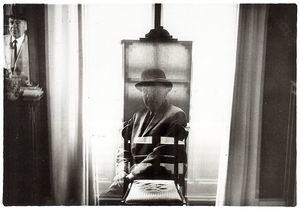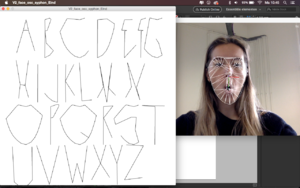User:B.Smulders
ABOUT
Bor Smulders
Graphic Design
Portofolio

Documents
First meeting
a stereoscopic viewer
Inspiration
QUARTER 1
The Crowbox Kit
Boijmans Object
Object
La reproduction interdite
Not to be Reproduced
by René Magritte - 1937
The thing that interested the Belgian surrealist artist Magritte was the mystery that lay in everyday visible reality. He was not so much inspired by the invisible, the subconscious and dream images but rather by ordinary objects to which he gave a twist. The man Magritte portrays here is the eccentric wealthy Englishman Edward James. He was a friend of the artist and bought various works from him. In the 1930s Edward James was the benefactor of both Dalí and Magritte. Magritte based the portrait on a photograph he made of Edward James looking at the painting 'On the threshold of freedom'.
Title: La reproduction interdite
Painter: René Magritte, Lessen 1898 - Brussel 1967
Year: 1937
Type of object: painting
Dimensions: 81,5 x 65,5 x 2 cm
Material and technique: oil on canvas
Source: Boijmans
René Magritte
Rene Magritte by Duane Stephen Michals - 1965
Belgian Surrealist painter. Born at Lessines. Studied at the Académie des Beaux-Arts in Brussels 1916-18, and settled in Brussels. Made his living for a time by designing wallpaper and drawing fashion advertisements. Became very friendly with poets and writers such as Mesens, Goemans, Scutenaire and Nougé, who shared his interest in evoking mystery and were later the founders of the Belgian Surrealist group. Turned away from his early Cubist-Futurist experiments in 1925 under the influence of de Chirico; began to explore ways of creating a poetic, disturbing effect by depicting recognisable objects in alien settings, by startling juxtapositions or combinations of objects, by inversions of scale and so on. First one-man exhibition at the Galerie Le Centaure, Brussels, 1927. Afterwards lived from 1927-30 at Perreux-sur-Marne, a suburb of Paris, where he met Miró, Arp, Tanguy, Dali, Buñuel, Eluard and Breton. In 1930 returned to Brussels, where he spent the rest of his life. A cycle of murals, 'The Enchanted Domain', was painted from his designs in the Casino at Knokke in 1951-3, and eight sculptures were made under his supervision in 1967 from themes in his paintings. Died in Brussels.
Source: Tate Modern - http://www.tate.org.uk/art/artists/rene-magritte-1553
Magritte's work frequently displays a collection of ordinary objects in an unusual context, giving new meanings to familiar things. The use of objects as other than what they seem is typified in his painting, 'The Treachery of Images' (La trahison des images), which shows a pipe that looks as though it is a model for a tobacco store advertisement. Magritte painted below the pipe "Ceci n'est pas une pipe" ("This is not a pipe"), which seems a contradiction, but is actually true: the painting is not a pipe, it is an image of a pipe. It does not "satisfy emotionally"—when Magritte was once asked about this image, he replied that of course it was not a pipe, just try to fill it with tobacco.
Magritte used the same approach in a painting of an apple: he painted the fruit and then used an internal caption or framing device to deny that the item was an apple. In these "Ceci n'est pas" works, Magritte points out that no matter how naturalistically we depict an object, we never do catch the item itself.
Among Magritte's works are a number of surrealist versions of other famous paintings. Elsewhere, Magritte challenges the difficulty of artwork to convey meaning with a recurring motif of an easel, as in his The Human Condition series (1933, 1935) or The Promenades of Euclid (1955) (wherein the spires of a castle are "painted" upon the ordinary streets which the canvas overlooks). In a letter to André Breton, he wrote of The Human Condition that it was irrelevant if the scene behind the easel differed from what was depicted upon it, "but the main thing was to eliminate the difference between a view seen from outside and from inside a room." The windows in some of these pictures are framed with heavy drapes, suggesting a theatrical motif.
Magritte's style of surrealism is more representational than the "automatic" style of artists such as Joan Miró. Magritte's use of ordinary objects in unfamiliar spaces is joined to his desire to create poetic imagery. He described the act of painting as "the art of putting colors side by side in such a way that their real aspect is effaced, so that familiar objects—the sky, people, trees, mountains, furniture, the stars, solid structures, graffiti—become united in a single poetically disciplined image. The poetry of this image dispenses with any symbolic significance, old or new."
René Magritte described his paintings as "visible images which conceal nothing; they evoke mystery and, indeed, when one sees one of my pictures, one asks oneself this simple question, 'What does that mean?'. It does not mean anything, because mystery means nothing either, it is unknowable."
Magritte's constant play with reality and illusion has been attributed to the early death of his mother. Psychoanalysts who have examined bereaved children have hypothesized that Magritte's back and forth play with reality and illusion reflects his "constant shifting back and forth from what he wishes—'mother is alive'—to what he knows—'mother is dead'
Contemporary artists have been greatly influenced by René Magritte's stimulating examination of the fickleness of images. Some artists who have been influenced by Magritte's works include John Baldessari, Ed Ruscha, Andy Warhol, Jasper Johns, Jan Verdoodt, Martin Kippenberger, Duane Michals and Storm Thorgerson. Some of the artists' works integrate direct references and others offer contemporary viewpoints on his abstract fixations.
Magritte's use of simple graphic and everyday imagery has been compared to that of the Pop artists. His influence in the development of Pop art has been widely recognized,[21] although Magritte himself discounted the connection. He considered the Pop artists' representation of "the world as it is" as "their error", and contrasted their attention to the transitory with his concern for "the feeling for the real, insofar as it is permanent." The 2006–2007 LACMA exhibition "Magritte and Contemporary Art: The Treachery of Images" examined the relationship between Magritte and contemporary art.
Source: Wikipedia - http://en.wikipedia.org/wiki/René_Magritte
Research
MENU
Boijmans Object


